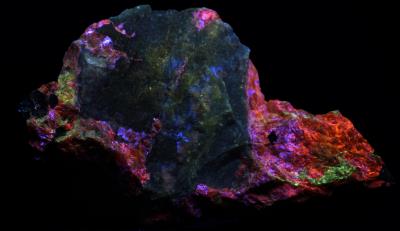 | |  |
Talc (light gray green), sphalerite (light redish tan, tan, gray), franklinite (black) and willemite from the Sterling Hill Mine, Ogdensburg, NJ. 4 1/2" x 2 1/4". From the collection of JVF, photo by WP.
| | Talc, sphalerite, franklinite and willemite from the Sterling Hill Mine, Ogdensburg, NJ under longwave UV light. The talc fluoresces weak dull yellow, sphalerite purple, orange and red, the franklinite and willemite are non-fluorescent. 4 1/2" x 2 1/4". From the collection of JVF, photo by WP. |
 | |  |
Talc, sphalerite, franklinite and willemite from the Sterling Hill Mine, Ogdensburg, NJ under midwave UV light. The talc fluoresces weak dull yellow, sphalerite blue, purple, orange, willemite green the franklinite is non-fluorescent. 4 1/2" x 2 1/4". From the collection of JVF, photo by WP.
| | Talc, sphalerite, franklinite and willemite from the Sterling Hill Mine, Ogdensburg, NJ under shortwave UV light. The talc fluoresces weak dull yellow, sphalerite blue, purple, orange, willemite green the franklinite is non-fluorescent. 4 1/2" x 2 1/4". From the collection of JVF, photo by WP. |
|
